A Proposed Planning Concept for Public Open Space Provision in Saudi Arabia: A Study of Three Saudi Cities
Abstract
:1. Introduction
1.1. Public Open Space Planning
1.2. Saudi Arabia Characteristics and Background
1.2.1. Population
1.2.2. Urban Expansion
1.2.3. Vision 2030
1.2.4. Urban Planning Challenges
1.2.5. Leisure and Recreation
1.2.6. Social Attitudes to Public Open Spaces
1.2.7. Pattern of Using Public Open spaces
1.3. Public Open Space Provision in Saudi Arabia
2. Methodological Approaches
2.1. Case Study Approach
2.2. On-Site Interviews and Observations
- Where do you live (neighborhood or district)?
- How do you reach this site (transportation method)?
- Do you have a POS near your home? If yes, do you use it?
- Why do you use this POS?
- Why do you use this site (the case study site)?
2.3. Online Questionnaire
2.4. Accessibility and Per Capita Measurement
2.5. Data Analysis
3. Results
3.1. User Preferences for Public Open Spaces and Patterns of Use
3.1.1. Online Survey Results
3.1.2. Semi-Structured Interview Results
3.2. Public Open Spaces Per Capita and Accessibility Measures
3.2.1. Riyadh Public Open Spaces Per Capita
3.2.2. Jeddah Public Open Spaces Per Capita
3.2.3. Dammam Public Open Spaces Per Capita
3.2.4. Public Open Space Accessibility
3.2.5. Public Open Spaces Monetary Value
4. Discussion
Criticisms and Suggestions for Saudi Arabia POS Planning
5. Conclusions
Author Contributions
Funding
Acknowledgments
Conflicts of Interest
Appendix A
| MoMRA Guidelines |
|---|
| MoMRA urban design guidelines |
| A manual on addressing and planning public open spaces in cities |
| Standards for designing, constructing, and maintaining public parks |
| Special regulations for esthetic elements in public spaces and beaches (sculptures) |
| Technical specifications for ‘greening’ projects |
| Greening project implementation manuals |
| A manual on irrigation for greening projects inside cities |
| A manual on the selection of plants for greening projects in different environments |
| Guidelines for selecting plants suitable for greening projects in different climate zones (2001) |
| Planning standards for recreational spaces in cities |
| Guidelines for preparing and updating the city master plan |
| Public Open Spaces Type | Area (m2) by Density | Access Method | Catchment Distance Radius - (m) | |
|---|---|---|---|---|
| Walking | Car | |||
| Pocket Parks | 800–3000 | x | 100–200 | |
| Children Parks | 900–6000 | x | 150–275 | |
| Residential Block Parks | 4000–5000 | x | 200–350 | |
| Residential Block Playgrounds | 3000–6000 | x | 250–500 | |
| Neighborhood Parks | 5000–10,000 | x | x | 400–800 |
| Neighborhood Sports Playgrounds | 15,000–35,000 | x | x | 1000 |
| District Parks | 20,000–60,000 | x | 2500–5000 | |
| City Parks | 70,000 | x | x | - |
| Amusement Parks | 2000 | x | - | |
| Camping Sites | varied | x | - | |
| Special Parks (Waterfront, Zoo, Planetarium, Natural Landscapes, etc.) | varied | x | - | |
| Recreation Parks | varied | x | - | |
| City | Area km2 | Weather | Average Temperature | Average Rainfall | Physical Env. | Population | ||
|---|---|---|---|---|---|---|---|---|
| Saudi | Non-Saudi | Growth Rate | ||||||
| Riyadh | 1913 | Dry and hot in the summer (April to September) cold in the winter (September to March) | Winter lower than 15°C Summer higher than 45°C | 10–20 mm | Desert | 3,153,478 | 2,118,513 | 4.1% |
| Jeddah | 1600 | Hot and dry desert climate with high humidity | 28°C, but in summer temperatures can go as high as 40°C | 45 mm | Desert/ Coastal | 1,729,192 | 1,728,602 | 3.8% |
| Dammam | 800 | Hot and dry desert climate | Average low and high temperature of around 20°C and 34°C, respectively | 54 mm | Desert/ Coastal | 549,925 | 364,568 | 2.3% |
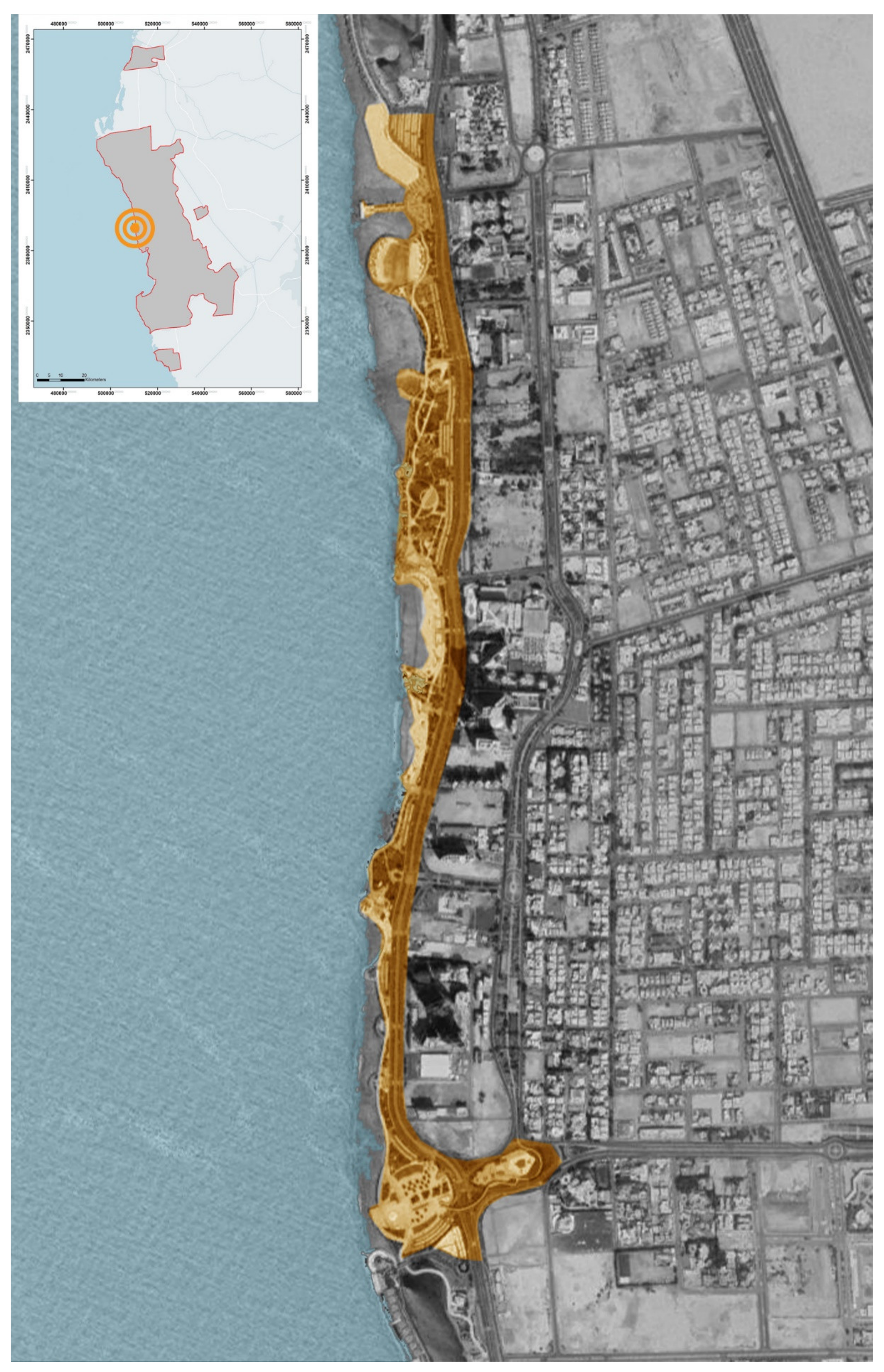
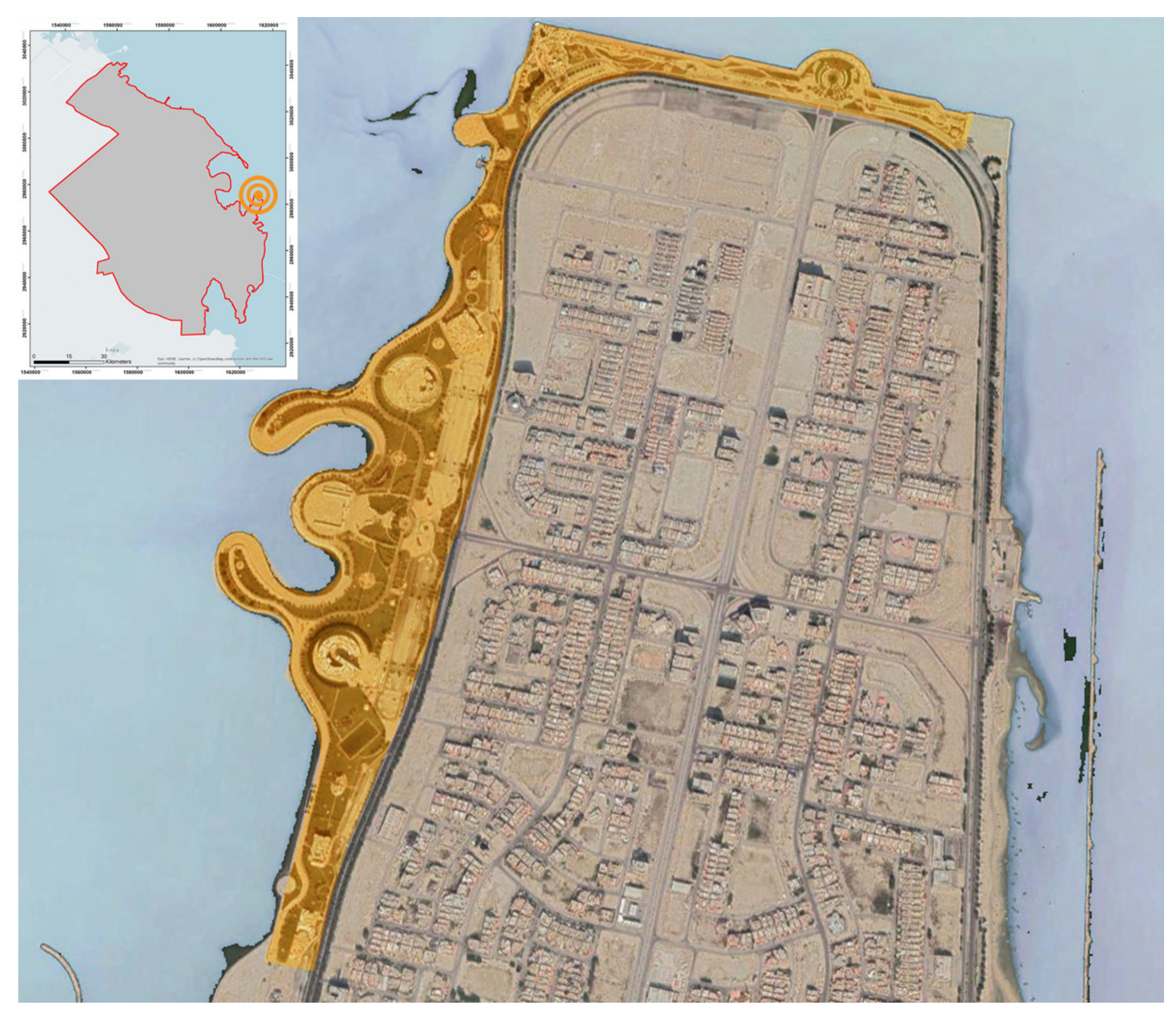
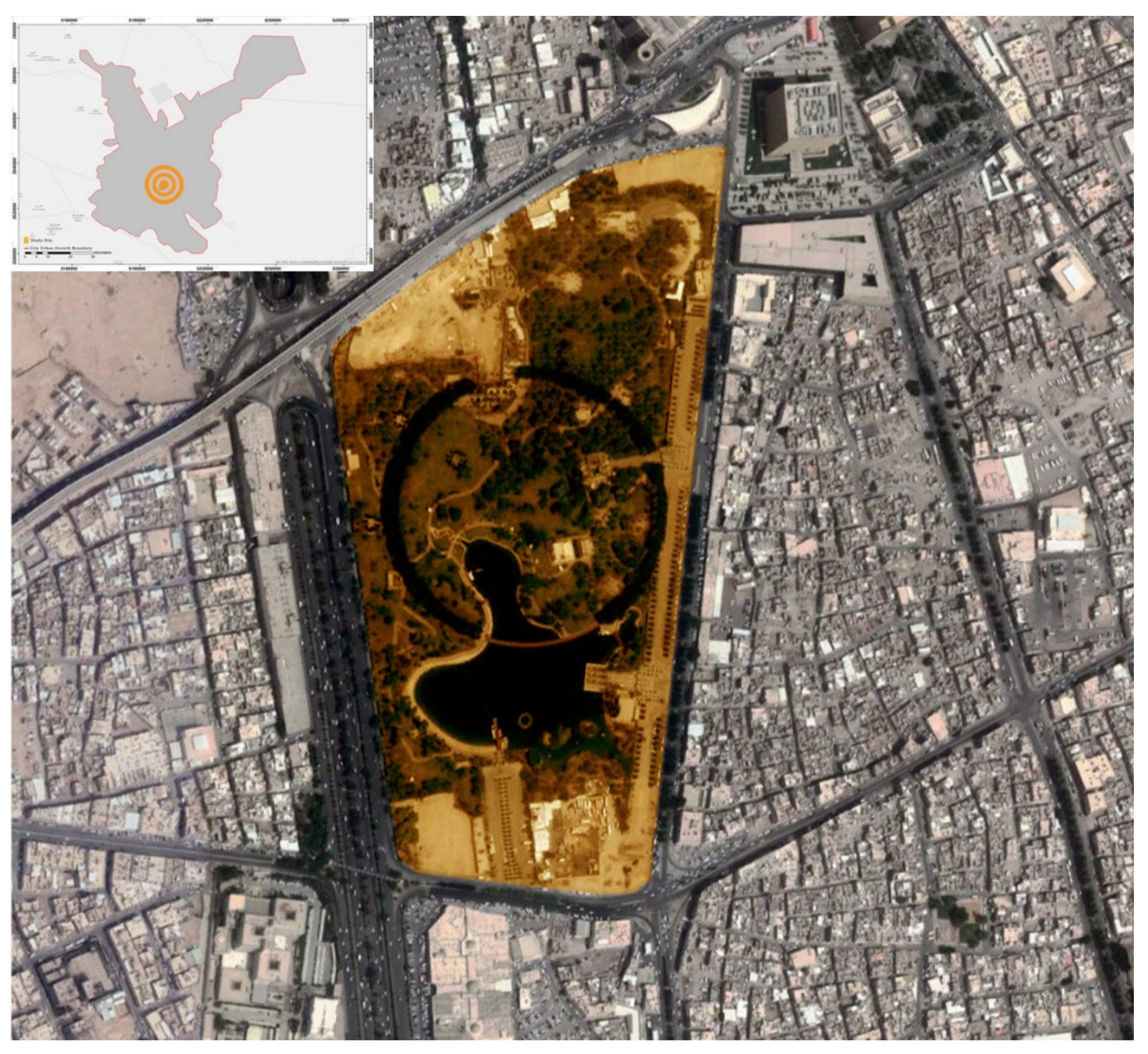
| Jeddah | Riyadh | Dammam | Total | Percent | |
|---|---|---|---|---|---|
| Male | 560 (75%) | 472 (70%) | 80 (44%) | 1112 | 70% |
| Female | 184 (25%) | 198 (30%) | 102 (56%) | 484 | 30% |
| Saudi | 696 (94%) | 646 (96%) | 174 (95%) | 1516 | - |
| Non-Saudi | 48 (6%) | 24 (4%) | 8 (5%) | 80 | - |
| 18–24 years | 79 | 97 | 20 | 196 | 12% |
| 25–34 years | 186 | 139 | 44 | 369 | 23% |
| 35–44 years | 68 | 88 | 39 | 195 | 12% |
| 45–54 years | 234 | 194 | 32 | 460 | 29% |
| Above 54 years | 177 | 152 | 47 | 376 | 24% |
| Respond | Jeddah | Riyadh | Dammam | |
|---|---|---|---|---|
| Nearby POS use | Used | 64 (16%) | 104 (29%) | 46 (34%) |
| Unused | 224 (55%) | 100 (28%) | 32 (24%) | |
| Occasionally used | 122 (30%) | 150 (32%) | 56 (33%) | |
| Neighborhood POS use | Used | 96 (23%) | 114 (22%) | 62 (34%) |
| Unused | 224 (51%) | 132 (26%) | 56 (31%) | |
| Occasionally used | 122 (28%) | 236 (52%) | 40 (36%) | |
| City-scale POS use | Used | 588 (79%) | 344 (51%) | 126 (69%) |
| Unused | 42 (6%) | 126 (19%) | 12 (7%) | |
| Occasionally used | 114 (15%) | 200 (30%) | 44 (24%) |
| Reason | Jeddah | Riyadh | Dammam | Total Responses |
|---|---|---|---|---|
| Friend gatherings | 14 | 18 | 4 | 36 (2%) |
| No reason | 30 | 42 | 4 | 76 (5%) |
| Escape from everyday routine | 314 | 144 | 68 | 526 (33%) |
| Family gatherings | 328 | 176 | 78 | 582 (37%) |
| Physical activity | 388 | 264 | 98 | 750 (47%) |
| Mental wellbeing | 484 | 242 | 112 | 838 (53%) |
| Picnics | 490 | 324 | 120 | 934 (59%) |
| Item | SD | D | N | A | SA | Mean | Std. D |
|---|---|---|---|---|---|---|---|
| Maintenance plays a role in my use of POS in general | 20 | 8 | 46 | 188 | 1334 | 4.76 | 0.649 |
| The design attracts me to the POS | 24 | 10 | 110 | 182 | 1270 | 4.67 | 0.760 |
| I enjoy the journey to the POS | 24 | 24 | 104 | 266 | 1178 | 4.60 | 0.801 |
| I do not feel like using the gardens in my area | 14 | 14 | 146 | 260 | 1162 | 4.59 | 0.763 |
| I prefer to use gardens and parks in large open areas | 78 | 36 | 296 | 360 | 826 | 4.14 | 1.102 |
| I prefer to use gardens and parks away from my home | 60 | 96 | 322 | 332 | 786 | 4.06 | 1.127 |
| A lack of a sense of security affects my use | 174 | 126 | 250 | 246 | 800 | 3.86 | 1.392 |
| The more users that are at a site, the more I use it | 82 | 166 | 472 | 292 | 584 | 3.71 | 1.207 |
| Vegetation and planting attract me to the POS | 180 | 250 | 326 | 148 | 692 | 3.58 | 1.450 |
| Site elements attract me to the POS | 196 | 154 | 524 | 270 | 452 | 3.39 | 1.318 |
| Water bodies attract me to the POS | 238 | 248 | 386 | 208 | 516 | 3.32 | 1.440 |
| Customs and tradition affect how I use POS | 780 | 224 | 268 | 142 | 182 | 2.20 | 1.414 |
| I do not use POS because I do not feel accepted socially | 856 | 200 | 248 | 124 | 168 | 2.09 | 1.394 |
| Jeddah | Riyadh | Dammam | Total | Percent | |
|---|---|---|---|---|---|
| Saudi Male | 106 | 85 | 87 | 278 | - |
| Saudi Female | 79 | 87 | 58 | 224 | - |
| Non-Saudi Male | 95 | 64 | 59 | 218 | - |
| Non-Saudi Female | 56 | 48 | 93 | 197 | - |
| Saudi | 185 | 172 | 145 | 502 | - |
| 18–24 years old | 43 | 43 | 39 | 125 | 25% |
| 25–34 years old | 27 | 35 | 36 | 98 | 19% |
| 35–44 years old | 49 | 29 | 35 | 113 | 23% |
| 45–54 years old | 43 | 49 | 24 | 116 | 23% |
| Above 54 years old | 23 | 16 | 12 | 51 | 10% |
| Non-Saudi | 151 | 112 | 152 | 415 | - |
| 18–24 years old | 19 | 22 | 25 | 66 | 16% |
| 25–34 years old | 40 | 27 | 33 | 100 | 24% |
| 35-44 years old | 49 | 31 | 55 | 135 | 33% |
| 45–54 years old | 23 | 20 | 24 | 67 | 16% |
| Above 54 years old | 20 | 12 | 14 | 46 | 11% |
| Item | Corr. Coefficient | |
|---|---|---|
| 1. | Water bodies attract me to the POS | 0.111 ** |
| 2. | I prefer to use gardens and parks in large open areas | 0.413 ** |
| 3. | Site elements attract me to the POS | 0.352 ** |
| 4. | Vegetation and planting attract me to the POS | 0.237 ** |
| 5. | The design attracts me to the POS | 0.495 ** |
| 6. | Maintenance plays a role in my use of POS in general | 0.509 ** |
| 7. | I enjoy the journey to the POS | 0.581 ** |
| 8. | The more users at the site, the more I use it | 0.529 ** |
| 9. | I do not feel like using the gardens in my area | 0.537 ** |
| 10. | I prefer to use gardens and parks away from my home | 0.497 ** |
| 11. | A lack of sense of security affects my use | 0.484 ** |
| 12. | I do not use POS because I do not feel accepted socially | 0.360 ** |
| 13. | Customs and tradition affect how I use POS | 0.305 ** |
| Number of items | Cronbach’s Alpha |
|---|---|
| 13 | 0.507 |
| Riyadh | Jeddah | Dammam | |
|---|---|---|---|
| Current spend (250 $/m2) | $1,540,391,750.00 | $512,623,250.00 | $1,381,733,250.00 |
| World Health Organization | $10,242,635,500.00 | $8,623,706,500.00 | $923,187,000.00 |
| Public Health Bureau USA | $22,025,662,750.00 | $17,760,036,250.00 | $3,228,107,250.00 |
| European Union | $32,499,464,750.00 | $25,881,218,250.00 | $5,276,925,250.00 |
| United Nations | $37,736,365,750.00 | $29,941,809,250.00 | $6,301,334,250.00 |
References
- Klaufus, C.; Lindert, P.V.; Noorloos, F.V.; Steel, G. All-Inclusiveness versus exclusion: Urban project development in Latin America and Africa. Sustainability 2017, 9, 2038. [Google Scholar] [CrossRef] [Green Version]
- Madureira, H.; Nunes, F.; Oliveira, J.V.; Madureira, T. Preferences for Urban Green Space Characteristics—A Comparative Study in Three Cities of Portuguese. Environments 2018, 5, 23. [Google Scholar] [CrossRef] [Green Version]
- Rahman, K.M.A.; Zhang, D. Analyzing the level of accessibility of public urban green spaces to different socially vulnerable groups of people. Sustainability 2018, 10, 3917. [Google Scholar] [CrossRef] [Green Version]
- Chen, J.; Chang, Z. Rethinking Urban Green Space Accessibility: Evaluating and Optimizing Public Transportation System through Social Network Study in Megacities. Landsc. Urban. Planing 2015, 143, 150–159. [Google Scholar] [CrossRef]
- Arnberger, A.; Eder, R. Are urban visitors’ general preferences for green-spaces similar to their preferences when seeking stress relief? Urban. For. Urban. Green. 2015, 14, 872–882. [Google Scholar] [CrossRef]
- Coolen, H.; Meesters, J. Private and public green spaces: Meaningful but different settings. J. Hous. Built Environ. 2012, 27, 49–67. [Google Scholar] [CrossRef] [Green Version]
- Francis, M. Childhood’s Garden: Memory and Meaning of Gardens. Children’s Environ. 1995, 12, 1–16. [Google Scholar]
- Dunnett, N.; Qasim, M. Perceived Benefits to Human Well-being of Urban Gardens. HortTechnology 2000, 10, 40–45. [Google Scholar] [CrossRef] [Green Version]
- Bishop, J.C.; Curtis, M.; Opie, I. Play Today in the Primary School Playground; Open University Press: London, UK, 2001. [Google Scholar]
- Armstrong, N. Promoting Physical Activity in Schools. Health Visit. 1993, 66, 362–364. [Google Scholar]
- Beveridge, C.; Rocheleau, P. Frederick Law Olmsted: Designing the American Landscape; Rizzoli: New York, NY, USA, 2005. [Google Scholar]
- Bundred, P.; Kitchinerb, D.; Buchanc, I. Prevalence of overweight and obese children between 1989 and 1998: Population based series of cross sectional studies. Br. Med. J. 2001, 322, 326–328. [Google Scholar] [CrossRef] [Green Version]
- Chandler, T. The man-modified climate of towns. Built Environ. Environ. Man 1978, 8, 1–25. [Google Scholar]
- Noble, D.G.; Bashford, R.I.; Baillie, S.R. The Breeding Bird Survey 1999; British Trust for Ornithology: Thetford, UK, 2000. [Google Scholar]
- Danzer, G.A. Public Places: Exploring Their History; American Association for State and Local History: Walnut Creek, TN, USA, 1997. [Google Scholar]
- Rugg, J. Defining the place of burial: What makes a cemetery? Mortality 2010, 5, 259–275. [Google Scholar] [CrossRef]
- Somper, J.P. Market Research: Property Values and Trees Feasibility Study; National Urban Forestry Unit: Gloucestershire, UK, 2001. [Google Scholar]
- Karade, R.M.; Kuchi, V.S.; Salma, Z. The role of green space for sustainable landscape development in urban areas. Acta Hortic. 2017, 1181, 73–76. [Google Scholar] [CrossRef]
- Matsuoka, R.H.; Kaplan, R. People needs in the urban landscape: Analysis of Landscape and Urban Planning contributions. Landsc. Urban. Plan. 2008, 84, 7–19. [Google Scholar] [CrossRef]
- Addas, A. Motivation and Attachment in the Use of Public Open Spaces in Jeddah, Saudi Arabia; The University of Sheffield: Sheffield, UK, 2015. [Google Scholar]
- Ulrich, R.S.; Simons, R.F.; Losito, B.D.; Fiorito, E.; Miles, M.A.; Zelson, M. Stress recovery during exposure to natural and urban environments. J. Environ. Psychol. 1991, 11, 201–230. [Google Scholar] [CrossRef]
- Gražulevičienė, R.; Andrušaitytė, S.; Dėdelė, A.; Gražulevičius, T.; Valius, L.; Kapustinskienė, V.; Bendokienė, I. Environmental Quality Perceptions and Health: A Cross-Sectional Study of Citizens of Kaunas, Lithuania. Int. J. Environ. Res. Public Health 2020, 17, 1–14. [Google Scholar] [CrossRef]
- Maas, J.; Verheij, R.A.; Groenewegen, P.P.; Vries, S.d.; Spreeuwenberg, P. Green space, urbanity, and health: How strong is the relation? J. Epidemiol. Community Health 2006, 60, 587–592. [Google Scholar] [CrossRef] [Green Version]
- Coombes, E.; Jones, A.P.; Hillsdon, M. The relationship of physical activity and overweight to objectively measured green space accessibility and use. Soc. Sci. Med. 2010, 70, 816–822. [Google Scholar] [CrossRef] [Green Version]
- Barrera, F.d.l.; Reyes-Paecke, S.; Banzhaf, E. Indicators for green spaces in contrasting urban settings. Ecol. Indic. 2016, 62, 212–219. [Google Scholar] [CrossRef]
- Sugiyama, T.; Thompson, C.W. Associations between characteristics of neighbourhood open space and older people’s walking. Urban. For. Urban. Green. 2008, 7, 41–51. [Google Scholar] [CrossRef]
- Gong, C.; Chen, J.; Yu, S. Biotic homogenization and differentiation of the flora in artificial and near-natural habitats across urban green spaces. Landsc. Urban. Plan. 2013, 120, 158–169. [Google Scholar] [CrossRef]
- Addas, A.; Goldblatt, R.; Rubinyi, S. Utilizing Remotely Sensed Observations to Estimate the Urban Heat Island Effect at a Local Scale: Case Study of a University Campus. Land 2020, 9, 191. [Google Scholar] [CrossRef]
- Maruani, T.; Amit-Cohen, I. Open space planning models: A review of approaches and methods. Landsc. Urban. Plan. 2007, 81, 1–13. [Google Scholar] [CrossRef]
- Thompson, C.W. Linking landscape and health: The recurring theme. Landsc. Urban. Plan. 2011, 99, 187–195. [Google Scholar] [CrossRef]
- Dave, S. Neighbourhood density and social sustainability in cities of developing countries. Sustain. Dev. 2011, 19, 189–205. [Google Scholar] [CrossRef]
- Talen, E. Neighborhoods as Service Providers: A Methodology for Evaluating Pedestrian Access. Environ. Plan. B Urban. Anal. City Sci. 2003, 30, 181–200. [Google Scholar] [CrossRef]
- LaRosa, D. Accessibility to greenspaces: GIS based indicators for sustainable planning in a dense urban context. Ecol. Indic. 2014, 42, 122–134. [Google Scholar] [CrossRef]
- El-Geneidy, A.M.; Levinson, D.M. Access to Destinations: Development of Accessibility Measures; University of Minnesota: Twin Cities, MN, USA, 2006. [Google Scholar]
- Halden, D.; Jones, P.L.; Wixey, S. Accessibility analysis literature review, measuring accessibility as experienced by different socially disadvantage groups, Working Paper 3. In Computer Science; University of Westminster: Westminster, UK, 2005. [Google Scholar]
- Ferré, M.B.; Guitart, A.O.; Ferret, M.P. Children and playgrounds in Mediterranean cities. Child. Geogr. 2006, 4, 173–183. [Google Scholar] [CrossRef]
- Krenichyn, K. The only place to go and be in the city: Women talk about exercise, being outdoors, and the meanings of a large urban park. Health Place 2006, 12, 631–643. [Google Scholar] [CrossRef]
- Lloyd, K.; Burden, J.; Kiewa, J. Young Girls and Urban Parks: Planning for Transition Through Adolescence. J. Park Recreat. Adm. 2008, 26, 21–38. [Google Scholar]
- Henderson, K.A.; Neff, L.J.; Sharpe, P.A.; Greaney, M.L.; Royce, S.W.; Ainsworth, B.E. It Takes a Village to Promote Physical Activity: The Potential for Public Park and Recreation Departments. J. Park Recreat. Adm. 2001, 19, 23–41. [Google Scholar]
- Griffin, S.F.; Wilson, D.K.; Wilcox, S.; Buck, J.; Ainsworth, B.E. Physical Activity Influences in a Disadvantaged African American Community and the Communities Proposed Solutions. Health Promot. Pract. 2008, 9, 180–190. [Google Scholar] [CrossRef] [PubMed] [Green Version]
- Rigolon, A.; Browning, M.H.E.M.; Lee, K.; Shin, S. Access to Urban Green Space in Cities of the Global South: A Systematic Literature Review. Urban. Sci. 2018, 2, 1–25. [Google Scholar] [CrossRef] [Green Version]
- Rigolon, A. A complex landscape of inequity in access to urban parks: A literature review. Landsc. Urban. Planing 2016, 153, 160–169. [Google Scholar] [CrossRef]
- Ewing, R. Is Los Angeles-Style Sprawl Desirable? J. Am. Plan. Assoc. 1997, 63, 107–126. [Google Scholar] [CrossRef]
- Lynch, K. A Theory of Good City Form; The MIT Press: Cambridge, MA, USA, 1981. [Google Scholar]
- Jacobs, A.; Appleyard, D. Toward an Urban Design Manifesto. J. Am. Plan. Assoc. 1987, 53, 112–120. [Google Scholar] [CrossRef] [Green Version]
- Crompton, J.L. The Impact of Parks on Property Values: A Review of the Empirical Evidence. J. Leisure Res. 2001, 33, 1–31. [Google Scholar] [CrossRef]
- Goheen, P.G. Public space and the geography of the modern city. Prog. Hum. Geogr. 1998, 22, 479–496. [Google Scholar] [CrossRef] [Green Version]
- Brown, G. A Theory of Urban Park Geography. J. Leisure Res. 2008, 40, 589–607. [Google Scholar] [CrossRef]
- Witten, K.; Hiscock, R.; Pearce, J.; Blakely, T. Neighbourhood Access to Open Spaces and the Physical Activity of Residents: A National Study. Prev. Med. 2008, 47, 299–303. [Google Scholar] [CrossRef]
- Kaczynski, A.T.; Havitz, M.E. Examining the Relationship between Proximal Park Features and Residents’ Physical Activity in Neighborhood Parks. J. Park Recreat. Adm. 2009, 27, 42–58. [Google Scholar]
- Sugiyama, T.; Francis, J.; Middleton, N.J.; Owen, N.; Giles-Corti, B. Associations between recreational walking and attractiveness, size, and proximity of neighborhood open spaces. Am. J. Public Health 2010, 100, 1752–1757. [Google Scholar] [CrossRef] [PubMed]
- Organization, W.H. Urban. Green Spaces: A Brief for Action; World Health Organization: Geneva, Switzerland, 2017. [Google Scholar]
- Natural England. Nature Nearby: Accessible Natural Greenspace Guidance; Natural England: Sheffield, UK, 2010. [Google Scholar]
- Pickard, B.R.; Daniel, J.; Mehaffey, M.; Jackson, L.E.; Neale, A. EnviroAtlas: A new geospatial tool to foster ecosystem services science and resource management. Ecosyst. Serv. 2015, 14, 45–55. [Google Scholar] [CrossRef] [Green Version]
- Ståhle, A. More green space in a denser city: Critical relations between user experience and urban form. Urban. Des. Int. 2010, 15, 1–32. [Google Scholar] [CrossRef] [Green Version]
- Lancaster, R.A. Recreation, Park and Open Space Standards and Guidelines; National Recreation and Park Association: Washington, DC, USA, 1983. [Google Scholar]
- Harrison, C.; Burgess, J.; Millward, A.; Dawe, G. Accessible Natural Greenspace in Towns and Cities: A Review of Appropriate Size and Distance Criteria; Natural England: Sheffield, UK, 1995. [Google Scholar]
- Ngom, R.; Gosselin, P.; Blais, C. Reduction of disparities in access to green spaces: Their geographic insertion and recreational functions matter. Appl. Geogr. 2016, 66, 35–51. [Google Scholar] [CrossRef]
- Jacobs, J. The Death and Life of Great American Cities; Reissue edition; Vintage: New York, NY, USA, 1961. [Google Scholar]
- Harun, N.Z.; Mansor, M.; Said, I. The Experience of Diversity in Open Spaces of Two Historical Towns in Malaysia. Procedia Soc. Behav. Sci. 2013, 85, 582–591. [Google Scholar] [CrossRef]
- Tveit, M.; Ode, Å.; Fry, G. Key concepts in a framework for analysing visual landscape character. Landsc. Res. 2007, 31, 229–255. [Google Scholar] [CrossRef]
- Gold, S. Nonuse of Neighborhood Parks. J. Am. Inst. Plan. 1972, 38, 369–378. [Google Scholar] [CrossRef]
- General Authority for Statistics. Saudi Arabia Population Statistics; General Authority for Statistics: Royadh, Saudi Arabia, 2019. [Google Scholar]
- Fakeeh, M.S. Saudization as a Solution for Unemployment: The Case of Jeddah Western Region; University of Glasgow: Glasgow, UK, 2010. [Google Scholar]
- Mandeli, K.N. Public Spaces in a Contemporary Urban Environment: Multi-Dimensional Urban Design Approach for Saudi cities; University of Newcastle: Newcastle, UK, 2011. [Google Scholar]
- Khalifa, H.K. Changing Childhood. In Saudi Arabia: A Historical Comparative Study of Three Female Generations; University of Hull: Hull, UK, 2001. [Google Scholar]
- Allan, G. Family Life: Domestic Roles and Social Organization; Wiley-Blackwell: Hoboken, NJ, USA, 1991. [Google Scholar]
- Khalil, A. Muslim Cities as a Pattern of Relationships: House-Mosque Relationship; University of Edinburgh: Edinburgh, UK, 1994. [Google Scholar]
- Saleh, M.A.E. Privacy and communal socialization: The role of space in the security of traditional and contemporary neighborhoods in Saudi Arabia. Habitat Int. 1997, 21, 167–184. [Google Scholar] [CrossRef]
- Addas, A. Landscape Architecture and the Saudi Arabia Quality of Life Program. Emir. J. Eng. Res. 2018, 24, 1–19. [Google Scholar]
- Addas, A. Enhanced Public Open Spaces Planning in Saudi Arabia to Meet National Transformation Program Goals. Current Urban Studies. Curr. Urban. Stud. 2020, 8, 184–204. [Google Scholar] [CrossRef]
- Alharbi, T.H. The Development of Housing in Jeddah: Changes in Built Form from the Traditional to the Modern; Newcastle University: Newcastle, UK, 1989. [Google Scholar]
- Sidky, T.; Bastawisi, A. Planning and Treatment of Urban Spaces within the Layout of Urban Expansion of the City. In Proceedings of the First Arab Housing Conference—Construction Sustainability in the Arab Region, Especially the Desert Environment, Cairo, Egypt, 23–26 September 2010. [Google Scholar]
- Bokhari, A. Jeddah: A Study in Urban Formation; University of Pennsylvania: Philadelphia, PA, USA, 1978. [Google Scholar]
- Akbar, J. Responsibility and the Traditional Muslim Built Environment; Massachusetts Institute of Technology: Cambridge, MA, USA, 1984. [Google Scholar]
- Alfahad, F. Following a Study on the Reasons Why Residents Do Not Use Gardens and Parks Al Majmaah Municipality Established a Program to Rehabilitate (20) Parks within Neighborhoods; Al Jazirah Newspaper: Doha, Qatar, 2008. [Google Scholar]
- Al-Hathloul, S.; Mughal, M.A. Creating identity in new communities: Case studies from Saudi Arabia. Landsc. Urban. Planing 1999, 44, 199–218. [Google Scholar] [CrossRef]
- Saleh, M.A.E. The transformation of residential neighborhood: The emergence of new urbanism in Saudi Arabian culture. Build. Environ. 2002, 37, 515–529. [Google Scholar] [CrossRef]
- Pigram, J. Outdoor Recreation and Resource Management; Palgrave Macmillan: London, UK, 1983. [Google Scholar]
- Addas, A.; Alserayhi, G. Quantitative Evaluation of Public Open Space per Inhabitant in the Kingdom of Saudi Arabia: A Case Study of the City of Jeddah. Sage Open 2020, 10, 1–18. [Google Scholar] [CrossRef]
- Tobi, H.; Brink, A.v.d. A process approach to research in landscape architecture In Research in Landscape Architecture: Methods and Methodology; Brink, A.v.d., Bruns, D., Tobi, H., Bell, S., Eds.; Routledge: Abingdon, UK, 2017; pp. 24–34. [Google Scholar]
- Kallus, R. From Abstract to Concrete: Subjective Reading of Urban Space. J. Urban. Des. 2001, 6, 129–150. [Google Scholar] [CrossRef]
- Kahana, E.; Lovegreen, L.; Kahana, B.; Kahana, M. Person, Environment, and Person-Environment Fit as Influences on Residential Satisfaction of Elders. Environ. Behav. 2003, 35, 434–453. [Google Scholar] [CrossRef]
- Vaus, D.D. Research Design in Social Research; SAGE Publications Ltd.: Ventura, CA, USA, 2001. [Google Scholar]
- Cullen, G. The Concise Townscape; Architectural Press: New York, NY, USA, 1995. [Google Scholar]
- Nicholls, S. Measuring the accessibility and equity of public parks: A case study using GIS. Manag. Leisure 2001, 6, 201–219. [Google Scholar] [CrossRef]
- Moseley, D.; Marzano, M.; Chetcuti, J.; Watts, K. Green networks for people: Application of a functional approach to support the planning and management of greenspace. Landsc. Urban. Planing 2013, 116, 1–12. [Google Scholar] [CrossRef]
- General Authority for Statistics. Services guide for Riyadh; General Authority for Statistics: Riyadh, Saudi Arabia, 2015. [Google Scholar]
- AlGarawi, A. Global City Focus Jeddah; Arcadis: Jeddah, Saudi Arabia, 2016. [Google Scholar]
- General Authority for Statistics. The Preliminary Results of General Authority for Statistics of Population and Housing for the Year 2010; General Authority for Statistics: Riyadh, Saudi Arabia, 2010. [Google Scholar]
- Tracy, S.J. Qualitative Research Methods: Collecting Evidence, Crafting Analysis, Communicating Impact, 1st ed.; Wiley-Blackwell: Hoboken, NJ, USA, 2013; p. 368. [Google Scholar]
- Joshi, A.; Kale, S.; Chandel, S.; Pal, D.K. Likert Scale: Explored and Explained. Br. J. Appl. Sci. Technol. 2015, 7, 396–403. [Google Scholar] [CrossRef]
- McPherson, G.; Simpson, J.R.; Peper, P.J.; Maco, S.E.; Xiao, Q. Municipal Forest Benefits and Costs in Five US Cities. J. For. 2005, 103, 411–416. [Google Scholar] [CrossRef]
- Price, L.; Matthews, B. Travel time as quality time: Parental attitudes to long distance travel with young children. J. Transp. Geogr. 2013, 32, 9–55. [Google Scholar] [CrossRef]
- Hillsdon, M.M.; Panter, J.R.; Foster, C.; Jones, A.P. The relationship between access and quality of urban green space with population physical activity. Public Health 2006, 120, 1127–1132. [Google Scholar] [CrossRef] [PubMed]
- Turel, H.S.; Yigit, E.M.; Altug, I. Evaluation of elderly people’s requirements in public open spaces: A case study in Bornova District (Izmir, Turkey). Build. Environ. 2007, 42, 2035–2045. [Google Scholar] [CrossRef]
- Mandeli, K. Public space and the challenge of urban transformation in cities of emerging economies: Jeddah case study. Cities 2019, 95, 1–11. [Google Scholar] [CrossRef]
- Lotfi, S.; Koohsari, M.J. Measuring objective accessibility to neighborhood facilities in the city (A case study: Zone 6 in Tehran, Iran). Cities 2009, 26, 133–140. [Google Scholar] [CrossRef]
- Bahriny, F.; Bell, S. Patterns of Urban Park Use and Their Relationship to Factors of Quality: A Case Study of Tehran, Iran. Sustainability 2020, 12, 1560. [Google Scholar] [CrossRef] [Green Version]
- Addas, A. The Creation of Outdoor Spaces and Public Engagement, Jeddah, Saudi Arabia. In Proceedings of the Creation/Reaction, Greenwich, UK, 10–13 September 2017; pp. 45–55. [Google Scholar]
- Carmona, M. Principles for public space design, planning to do better. Urban. Des. Int. 2019, 24, 47–59. [Google Scholar] [CrossRef] [Green Version]
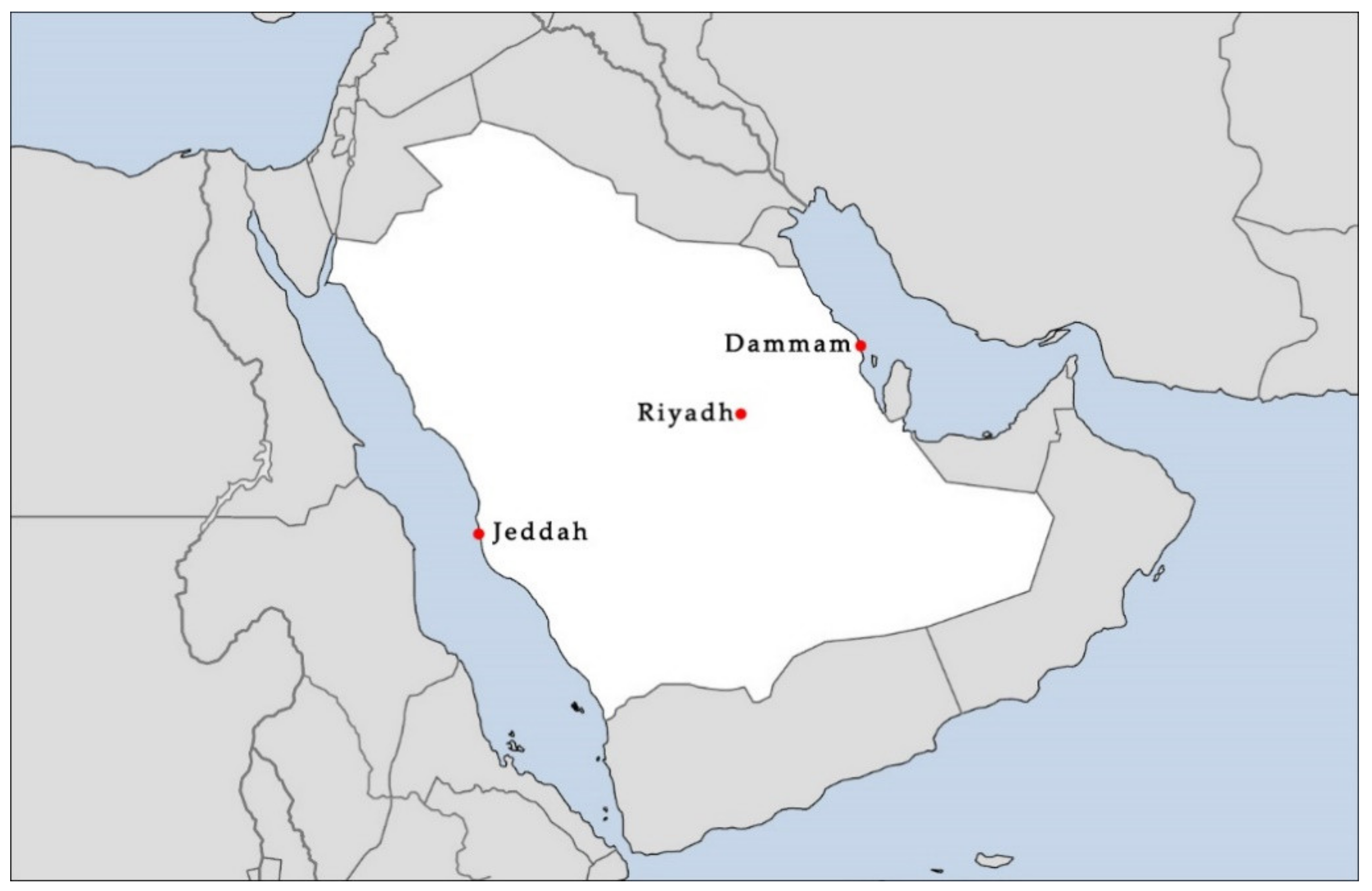
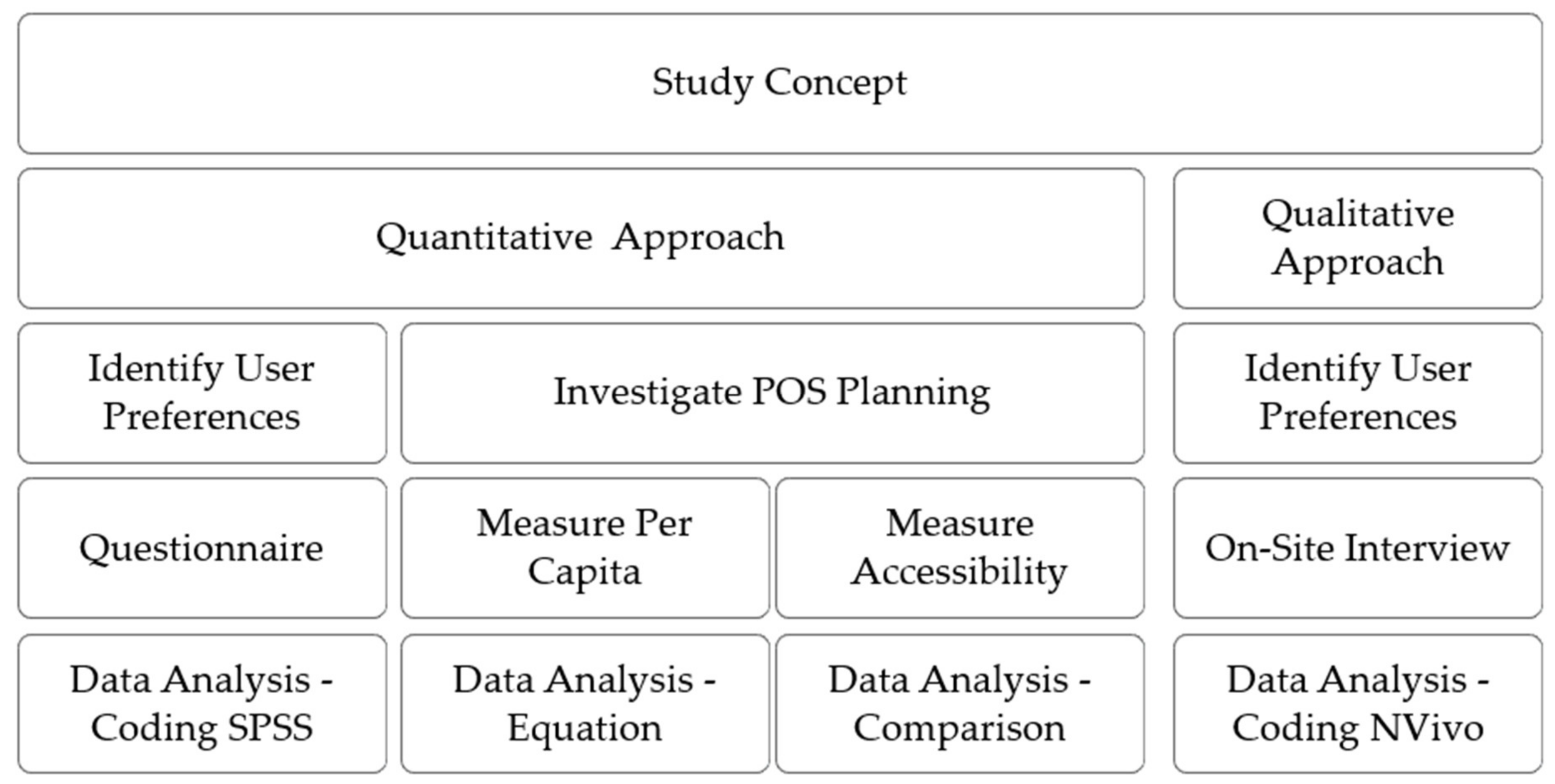
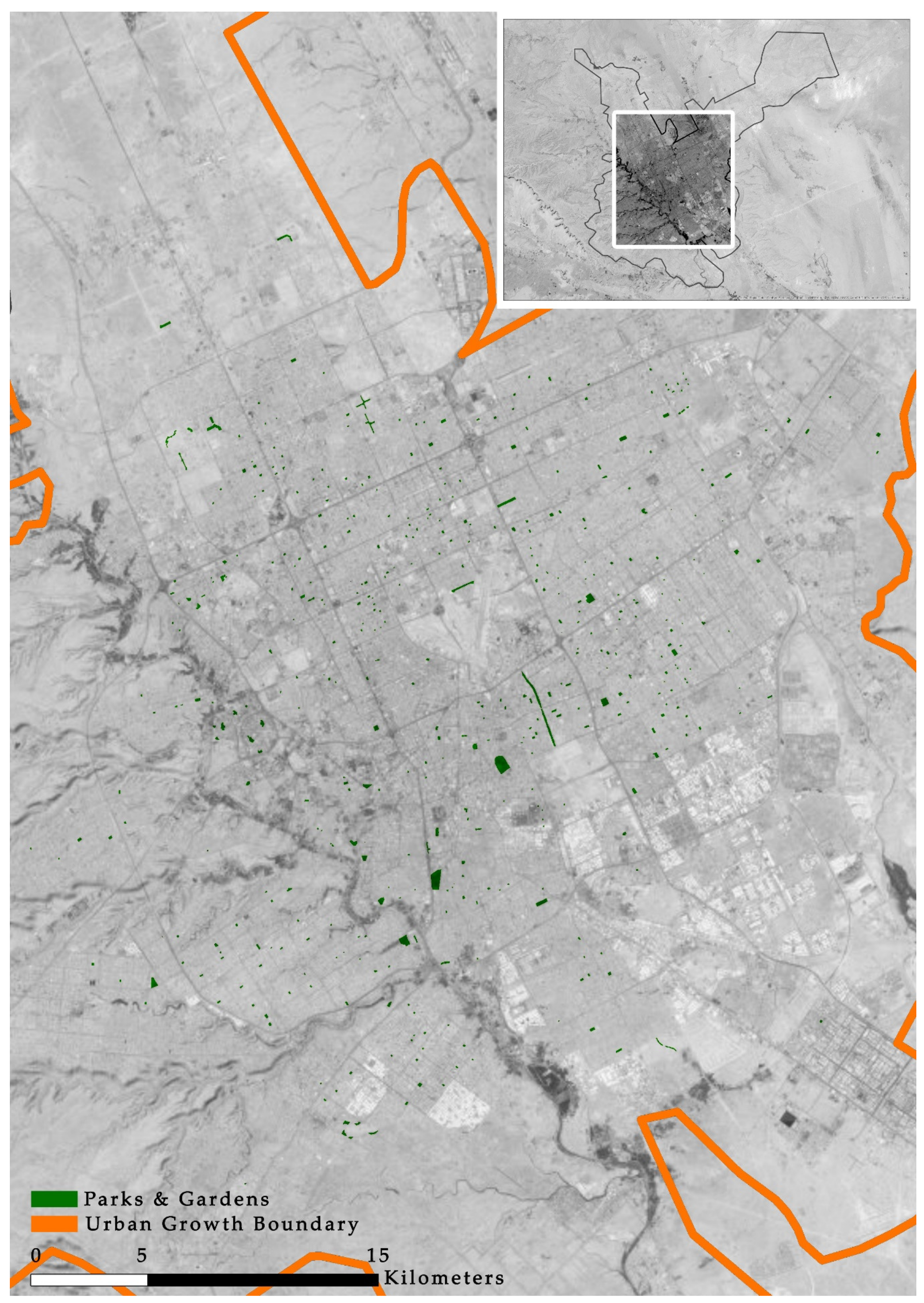
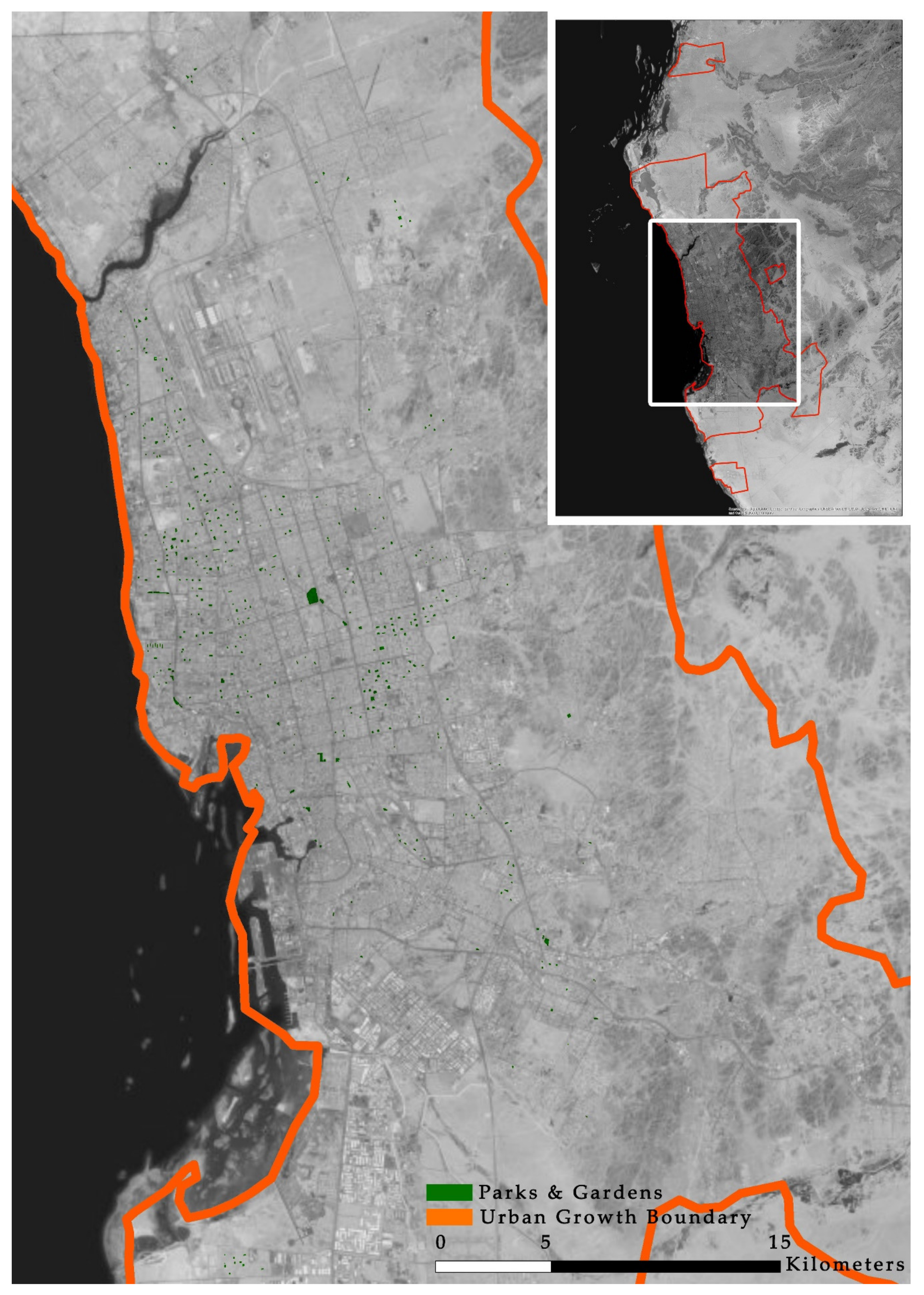
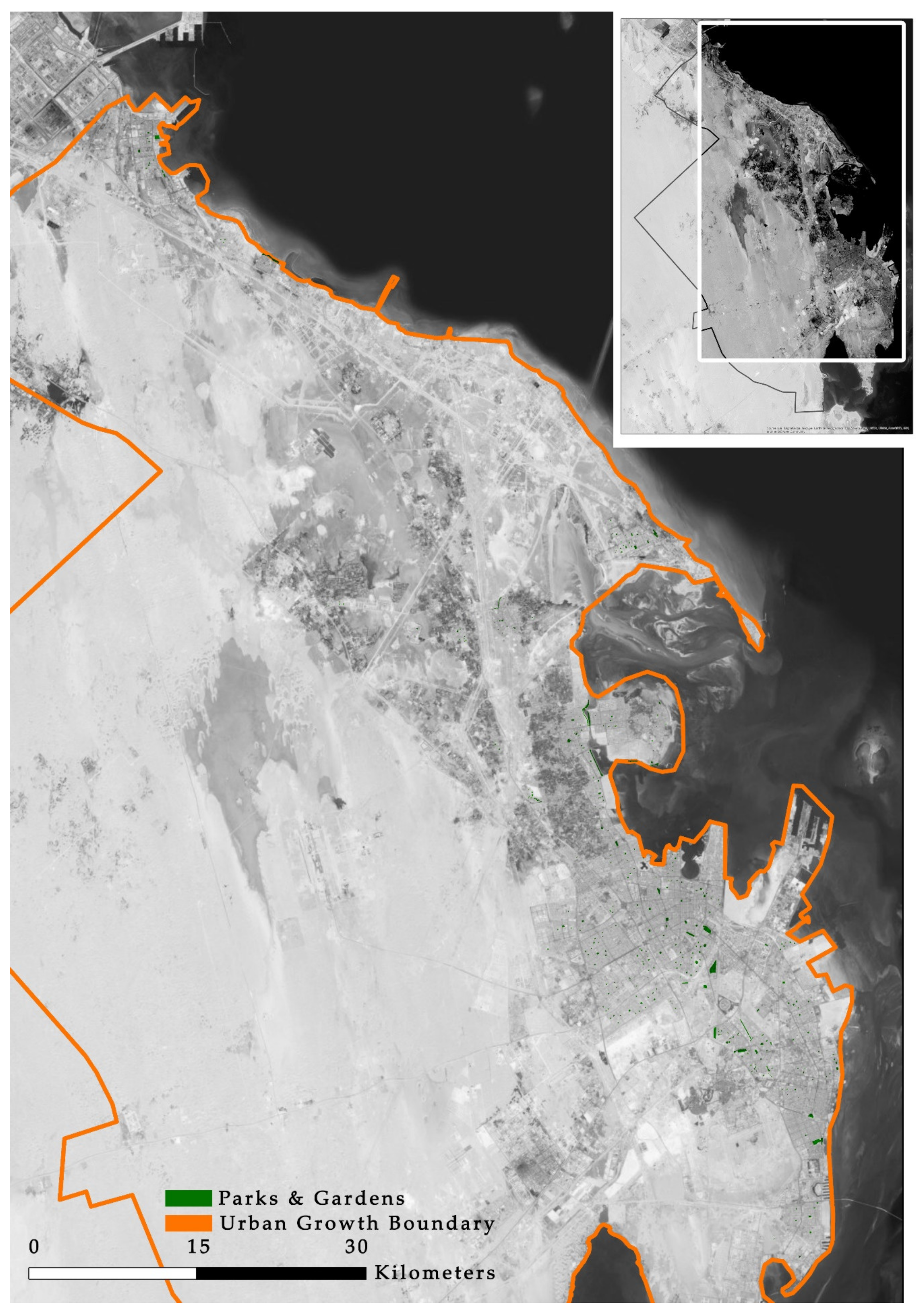
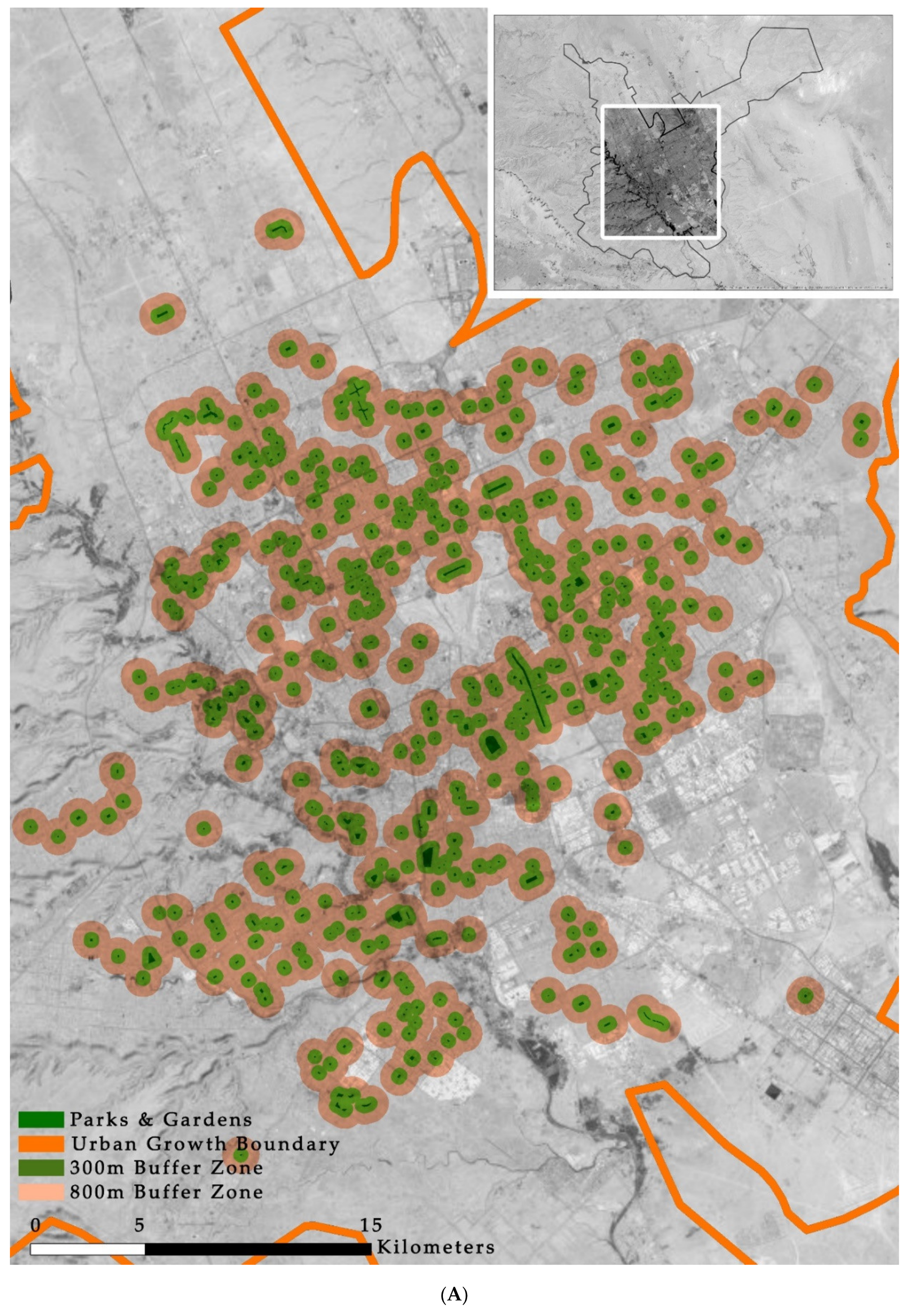

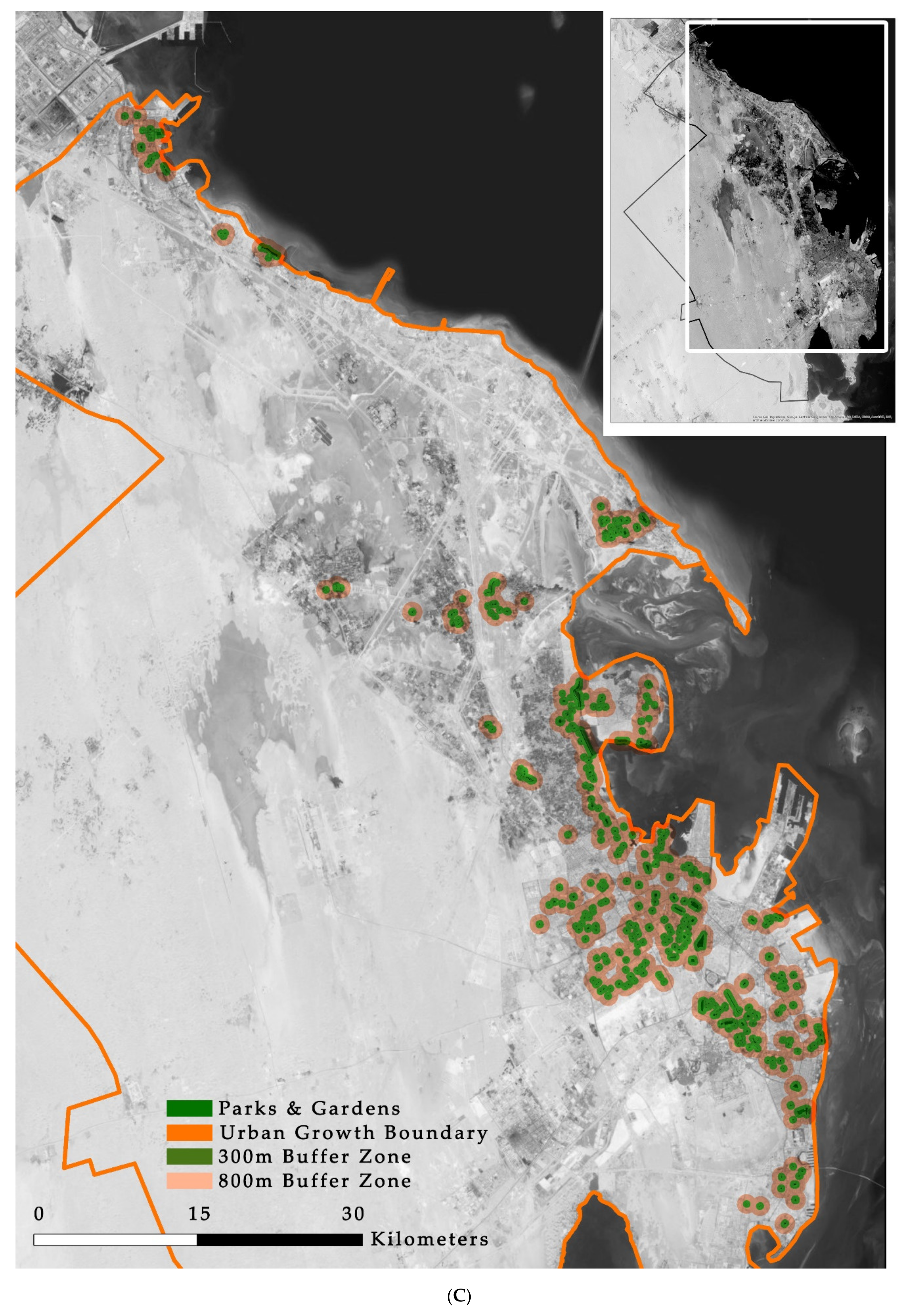
| Organization | Standard m2/Capita | POS Per Capita m2 | Required POS Area to Achieve Standard m2 | Shortage in m2 |
|---|---|---|---|---|
| World Health Organization | 9 | 1.18 | 47,132,109.00 | 40,970,542.00 |
| Public Health Bureau USA | 18 | 94,264,218.00 | 88,102,651.00 | |
| European Union | 26 | 136,159,426.00 | 129,997,859.00 | |
| United Nations | 30 | 157,107,030.00 | 150,945,463.00 |
| Organization | Standard m2/Capita | POS Per Capita m2 | Required POS Area to Achieve Standard m2 | Shortage in m2 |
|---|---|---|---|---|
| World Health Organization | 9 | 5.4 | 36,545,319.00 | 34,494,826.00 |
| Public Health Bureau USA | 18 | 73,090,638.00 | 71,040,145.00 | |
| European Union | 26 | 105,575,366.00 | 103,524,873.00 | |
| United Nations | 30 | 121,817,730.00 | 119,767,237.00 |
| Organization | Standard m2/Capita | POS Per Capita m2 | Required POS Area to Achieve Standard m2 | Shortage in m2 |
|---|---|---|---|---|
| World Health Organization | 9 | 5.4 | 9,219,681.00 | 3,692,748.00 |
| Public Health Bureau USA | 18 | 18,439,362.00 | 12,912,429.00 | |
| European Union | 26 | 26,634,634.00 | 21,107,701.00 | |
| United Nations | 30 | 30,732,270.00 | 25,205,337.00 |
| City | POS Number | POS > 20,000 m2 | Percentage |
|---|---|---|---|
| Riyadh | 450 | 61 | 14% |
| Jeddah | 432 | 7 | 2% |
| Dammam | 367 | 49 | 13% |
© 2020 by the authors. Licensee MDPI, Basel, Switzerland. This article is an open access article distributed under the terms and conditions of the Creative Commons Attribution (CC BY) license (http://creativecommons.org/licenses/by/4.0/).
Share and Cite
Addas, A.; Maghrabi, A. A Proposed Planning Concept for Public Open Space Provision in Saudi Arabia: A Study of Three Saudi Cities. Int. J. Environ. Res. Public Health 2020, 17, 5970. https://doi.org/10.3390/ijerph17165970
Addas A, Maghrabi A. A Proposed Planning Concept for Public Open Space Provision in Saudi Arabia: A Study of Three Saudi Cities. International Journal of Environmental Research and Public Health. 2020; 17(16):5970. https://doi.org/10.3390/ijerph17165970
Chicago/Turabian StyleAddas, Abdullah, and Ahmad Maghrabi. 2020. "A Proposed Planning Concept for Public Open Space Provision in Saudi Arabia: A Study of Three Saudi Cities" International Journal of Environmental Research and Public Health 17, no. 16: 5970. https://doi.org/10.3390/ijerph17165970
APA StyleAddas, A., & Maghrabi, A. (2020). A Proposed Planning Concept for Public Open Space Provision in Saudi Arabia: A Study of Three Saudi Cities. International Journal of Environmental Research and Public Health, 17(16), 5970. https://doi.org/10.3390/ijerph17165970






